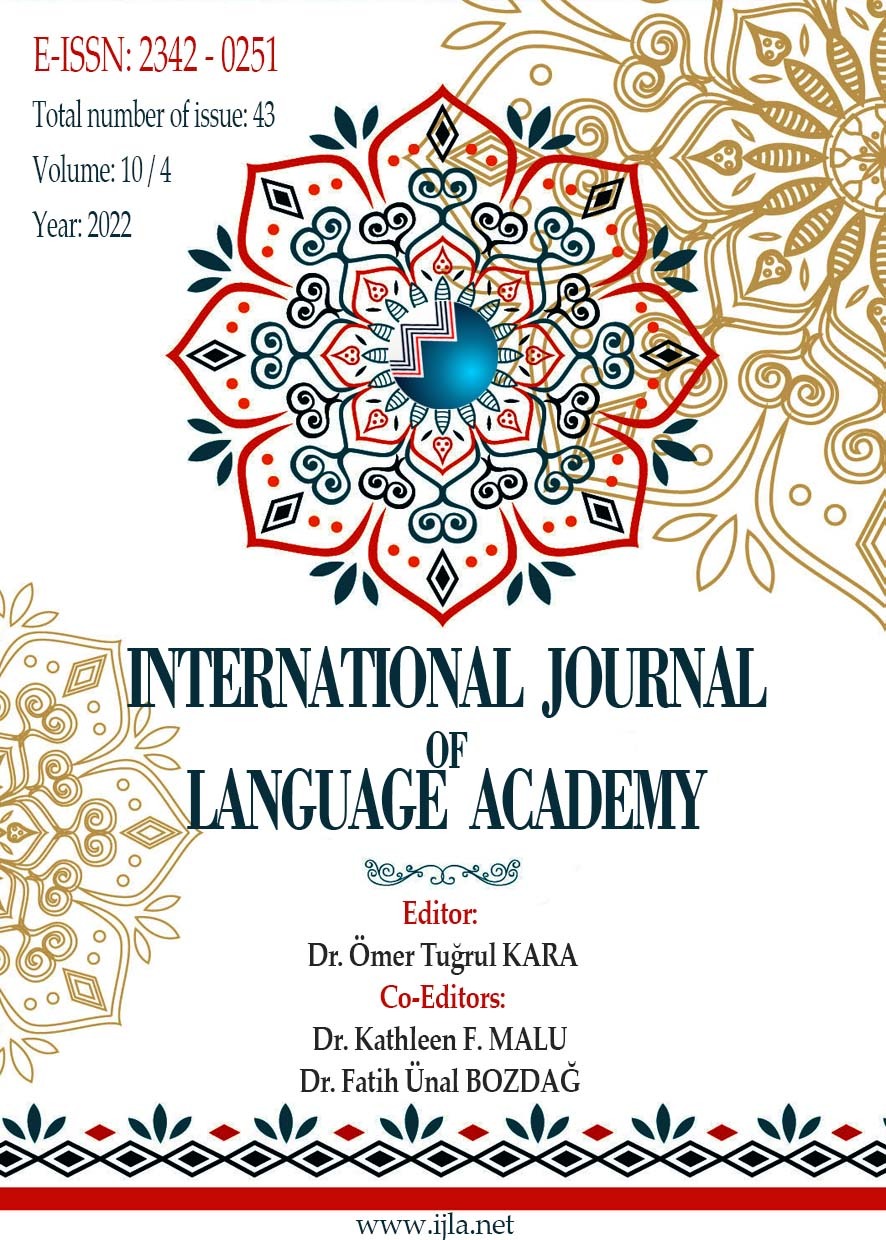YABANCI DİL OLARAK TÜRKÇE ÖĞRETİMİNDE OKUMA VE ANLAMA BECERİSİNE YÖNELİK SINIF İÇİ TAMAMLAYICI DEĞERLENDİRME: ÖĞRETİM ELEMANI UYGULAMALARI ÜZERİNE BİR İNCELEME
Author :
Abstract
Sınıf içi tamamlayıcı değerlendirme; gözlemler, özbildirim ölçekleri, gelişim çizelgeleri, üretkenlik dökümü, katılım ve görev tutanağı, öğrenci ürün dosyası olmak üzere altı görev biçimini içerir. Öğrencilerin okuma ve anlama becerilerinin gelişimini izlemek ve beceri gelişimini desteklemek için öğretim elemanın öğretim sürecinde bu görev biçimlerine işlevsel biçimde yer vermesi gerekir. Öğretim elemanlarının yabancı dil olarak Türkçe öğretimi sürecinde okuma ve anlama becerisine yönelik sınıf içi tamamlayıcı değerlendirme uygulamalarına ne sıklıkla yer verdiğini saptamayı amaçlayan bu çalışma betimsel niteliktedir. Çalışmanın katılımcılarını 65 öğretim elemanı oluşturmuştur. Katılımcıların okuma ve anlama becerisine yönelik sınıf içi tamamlayıcı değerlendirme uygulamasını ne sıklıkta işe koştuğunu belirlemek için altı alt boyut ve yirmi beş maddeden oluşan 4’lü Likert biçiminde bir sormaca geliştirilmiştir. Sormacanın kapsam geçerliği için iki Türkçe eğitimi alan uzmanından görüş alınmıştır. Veriler Google form ile toplanmış ve SPSS istatistik paket programına aktarılarak sıklıkları, yüzdelikleri ve aritmetik ortalamaları çözümlenmiştir. Yapılan çözümleme sonucunda, katılımcıların gözlem, üretkenlik dökümü ve özbildirim ölçekleri görev biçimlerini genellikle kullandıkları görülmüştür. Öte yandan, katılımcıların katılım ve görev tutanağı, öğrenci ürün dosyası ve gelişim çizelgeleri görev biçimlerini ise bazen kullandıkları görülmüştür. Katılımcıların tamamlayıcı değerlendirme biçimlerini kullanma sıklığının ise genellikle biçiminde olduğu saptanmıştır. Katılımcıların gözlem görev biçimlerini en sık, gelişim çizelgelerini ise en az kullanıyor olmaları dikkat çekicidir.
Keywords
Abstract
Classroom-based alternative assessment includes six task formats: Observations, self-reporting measures, progress charts, performance inventories, participation and engagement records, and portfolios. In order to monitor the development of students' reading and comprehension skills and to support skill development, the instructor should include these task formats in the teaching process in a practical way. This descriptive study aims to determine how often instructors include classroombased alternative assessment practices for reading and comprehension skills in teaching Turkish as a foreign language. The participants of the study consisted of 65 instructors. A 4-point Likert-type questionnaire consisting of six sub-dimensions and twenty-five items was developed to determine how often the participants used the classroom-based alternative assessment application for reading and comprehension skills. For the content validity of the questionnaire, opinions were taken from two Turkish language education experts. The data were collected with Google Forms and transferred to the Spss package program, and their frequencies, percentages, and arithmetic averages were analyzed. As a result of the analysis, it was seen that the participants generally used the task formats of observations, performance inventories, and self-reporting measures. On the other hand, it was observed that the participants sometimes used the form of participation and engagement records, portfolios, and progress charts. The frequency of the use of alternative assessment task formats was determined in general. It is noteworthy that the participants use the observation task formats most frequently and the progress charts the least.
Keywords
- Altun Alkan, H. ve Çetinkaya, G. (2021). Okuma çıraklığı yaklaşımı. İ. S. Aydın ve Ö. Yahşi (Eds.), içinde, Pisa ve okuma kültürü (s. 63-84). Ankara: Nobel yayınevi
- Aykaç, M. ve Çetinkaya, G. (2019). Konuşma becerisi ve yaratıcı drama. G. Çetinkaya (Ed.), Konuşma ve eğitimi içinde (s. 259-284). Ankara: Pegem Akademi.
- Brown, J. D., & Hudson, T. (1998). The alternatives in language assessment. TESOL Quarterly, 32(4), 653-675.
- Charvade, M. R., Jahandar, S. & Khodabandehlou, M. (2012). The impact of portfolio assessment on efl learners’ reading comprehension ability. English Language Teaching, 5(7), 129-139.
- Çetinkaya, G. ve Şentürk, R. (2021) Dinleme eğitiminde ölçme ve değerlendirme. N. Bayat (Eds.), Dinleme ve eğitimi içinde (s. 313-364). Ankara: Anı Yayıncılık.
- Çetinkaya, G. ve Yolcusoy, Ö. (2020). Okuduğunu anlamayı değerlendirmeye dönük ölçünleştirilmiş görev biçimleri: Yabancılara Türkçe öğretimi ders kitapları üzerine karşılaştırmalı bir inceleme. HAYEF: Journal of Education, 17(2), 176-198.
- Erskine, J. L. (2014). It changes how teachers teach: How testing is corrupting our classrooms and student learning. Multicultural Education, 21(2), 38-40.
- Garrison, C., & Ehringhaus, M. (2007). Formative and summative assessments in the classroom. http://www.amle.org/Publications/WebExclusive/Assessment/tabid /1120/Default.aspx
- Grabe, W. (2009). Reading in a second language: Moving from theory to practice. USA: Cambridge University Press.
- Harmer, J. (2007). The practice of English language teaching. England: Pearson.
- Hosseini, H. & Ghabanchi, Z. (2014). The effect of portfolio assessment on efl learners’ reading comprehension and motivation. English Language Teaching, 7(5), 110119. http://dx.doi.org/10.5539/elt.v7n5p110
- Jia, Y., Eslami, Z. E. & Burlbaw, L. M. (2006) ESL teachers' perceptions and factors influencing their use of classroom-based reading assessment. Bilingual Research Journal: The Journal of the National Association for Bilingual Education, 30(2), 407-430. DOI: 10.1080/15235882.2006.10162883
- Monteiro, V. (2013). Promoting reading motivation by reading together. Reading Psychology, 34(4), 301-335.





